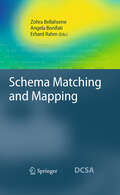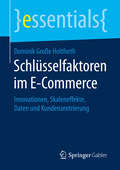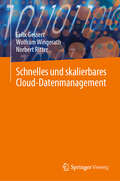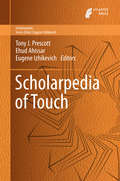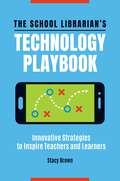- Table View
- List View
Scheduling of Large-scale Virtualized Infrastructures: Toward Cooperative Management
by Flavien QuesnelSystem virtualization has become increasingly common in distributed systems because of its functionality and convenience for the owners and users of these infrastructures. In Scheduling of Large-scale Virtualized Infrastructures, author Flavien Quesnel examines the management of large-scale virtual infrastructures with an emphasis on scheduling up to 80,000 virtual machines on 8,000 nodes. The text fills a need for updated software managing to meet the increasing size of virtual infrastructures. Virtual machine managers and virtual operators will appreciate this guide to improvement in cooperative software management.
Scheduling of Large-scale Virtualized Infrastructures: Toward Cooperative Management
by Flavien QuesnelSystem virtualization has become increasingly common in distributed systems because of its functionality and convenience for the owners and users of these infrastructures. In Scheduling of Large-scale Virtualized Infrastructures, author Flavien Quesnel examines the management of large-scale virtual infrastructures with an emphasis on scheduling up to 80,000 virtual machines on 8,000 nodes. The text fills a need for updated software managing to meet the increasing size of virtual infrastructures. Virtual machine managers and virtual operators will appreciate this guide to improvement in cooperative software management.
Scheduling Real-Time Streaming Applications onto an Embedded Multiprocessor (Embedded Systems #24)
by Orlando Moreira Henk CorporaalThis book provides a comprehensive overview of the state-of-the-art, data flow-based techniques for the analysis, modeling and mapping technologies of concurrent applications on multi-processors. The authors present a flow for designing embedded hard/firm real-time multiprocessor streaming applications, based on data flow formalisms, with a particular focus on wireless modem applications. Architectures are described for the design tools and run-time scheduling and resource management of such a platform.
Scheduling Theory: Multi-Stage Systems (Mathematics and Its Applications #285)
by V. Tanaev Yuri N. Sotskov V.A. StrusevichAn increasing interest to scheduling theory can be attributed to the high level of automation of all branches of human activity. The quality of modern production essentially depends on the planning decisions taken at different stages of a production process. Moreover, while the quality of these decisions is improving, the time and flexibility requirements for decision-making are becoming more important. All this stimulates scheduling research. Started as an independent discipline in the early fifties, it now has become an important branch of operations research. In the eighties, the largest Russian publishing house for scientific literature Nauka Publishers, Moscow, issued two books by a group of Byelorussian mathematicians: Scheduling Theory. Single-Stage Systems by V. S. Tanaev, V. S. Gordon and Y. M. Shafransky (1984) and Scheduling Theory. Multi-Stage Systems by V. S. Tanaev, Y. N. Sotskov and V. A. Strusevich (1989). Originally published in Russian, these two books cover two different major problem areas of scheduling theory and can be considered as a two-volume monograph that provides a systematic and comprehensive exposition of the subject. The authors are grateful to Kluwer Academic Publishers for creating the opportunity to publish the English translations of these two books. We are indebted to M. Hazewinkel, J. K. Lenstra, A. H. G. Rinnooy Kan, D. B. Shmoys and W. Szwarc for their supporting the idea of translating the books into English.
Scheduling Theory. Single-Stage Systems (Mathematics and Its Applications #284)
by V. Tanaev W. Gordon Yakov M. ShafranskyScheduling theory is an important branch of operations research. Problems studied within the framework of that theory have numerous applications in various fields of human activity. As an independent discipline scheduling theory appeared in the middle of the fifties, and has attracted the attention of researchers in many countries. In the Soviet Union, research in this direction has been mainly related to production scheduling, especially to the development of automated systems for production control. In 1975 Nauka ("Science") Publishers, Moscow, issued two books providing systematic descriptions of scheduling theory. The first one was the Russian translation of the classical book Theory of Scheduling by American mathematicians R. W. Conway, W. L. Maxwell and L. W. Miller. The other one was the book Introduction to Scheduling Theory by Soviet mathematicians V. S. Tanaev and V. V. Shkurba. These books well complement each other. Both. books well represent major results known by that time, contain an exhaustive bibliography on the subject. Thus, the books, as well as the Russian translation of Computer and Job-Shop Scheduling Theory edited by E. G. Coffman, Jr., (Nauka, 1984) have contributed to the development of scheduling theory in the Soviet Union. Many different models, the large number of new results make it difficult for the researchers who work in related fields to follow the fast development of scheduling theory and to master new methods and approaches quickly.
Schema Matching and Mapping (Data-Centric Systems and Applications)
by Zohra Bellahsene, Angela Bonifati and Erhard RahmRequiring heterogeneous information systems to cooperate and communicate has now become crucial, especially in application areas like e-business, Web-based mash-ups and the life sciences. Such cooperating systems have to automatically and efficiently match, exchange, transform and integrate large data sets from different sources and of different structure in order to enable seamless data exchange and transformation. The book edited by Bellahsene, Bonifati and Rahm provides an overview of the ways in which the schema and ontology matching and mapping tools have addressed the above requirements and points to the open technical challenges. The contributions from leading experts are structured into three parts: large-scale and knowledge-driven schema matching, quality-driven schema mapping and evolution, and evaluation and tuning of matching tasks. The authors describe the state of the art by discussing the latest achievements such as more effective methods for matching data, mapping transformation verification, adaptation to the context and size of the matching and mapping tasks, mapping-driven schema evolution and merging, and mapping evaluation and tuning. The overall result is a coherent, comprehensive picture of the field.With this book, the editors introduce graduate students and advanced professionals to this exciting field. For researchers, they provide an up-to-date source of reference about schema and ontology matching, schema and ontology evolution, and schema merging.
Schließen bei unsicherem Wissen in der Künstlichen Intelligenz: Vergleich von Formalismen anhand eines Beispiels (Künstliche Intelligenz)
by Léa SombéSchluss mit 08/15-Websites – so bringen Sie Ihr Online-Marketing auf Erfolgskurs: 79 Tipps für Ihren Online-Auftritt
by Bastian SensDieses Buch zeigt Ihnen, wie Sie mit einer optimierten Website und Online-Marketing den Erfolg Ihres Unternehmens in die Hand nehmen können. Tipps und Tricks aus der Praxis helfen Ihnen, nicht nur im Kampf um die besten Google-Platzierungen ganz oben mitzumischen, sondern auch langfristig Kunden zu gewinnen und zu binden. Denn Hand aufs Herz: Können Sie sich erinnern, welche Websites Sie gestern besucht haben? Es dürften sehr wenige sein, und das ist kein Wunder. Denn während sämtliche Unternehmen im Web mit oft wenig überzeugenden Inhalten um unsere Aufmerksamkeit buhlen und immer noch mit nervigen Bannern oder Pop-ups um Kunden kämpfen, wenden wir uns genervt ab. Erinnern können wir uns höchstens daran, dass es mal wieder Zeit war, eine Seite zu schließen. Nur ganz wenige Unternehmens-Websites hinterlassen einen positiven und bleibenden Eindruck. Schade eigentlich.Machen Sie Schluss mit 08/15-Websites. Nutzen Sie das Expertenwissen von Online-Marketing-Profi Bastian Sens und geben Sie mit diesen 79 Tipps Ihrem Auftritt im Web eine persönliche Note. Entwickeln Sie eine markante Website, an die sich die Besucher auch morgen noch gerne erinnern.Handlich, leicht verständlich und vor allem praxisnah – Bastian Sens gibt 79 Tipps, die jederzeit leicht umgesetzt werden können.Tina Bergner – Marketing, Ducati Motor Holding S.p.A. Eine gute Website berührt den Kopf, den Bauch und das Herz eines Kunden und erweckt so die eigene Marke zum Leben. Bastian Sens gibt sein Praxiswissen weiter, damit auch Sie Ihre Website zum Leben erwecken können.Prof. Dr. Hanns-Ferdinand Müller – Vorstand der FORIS AG
Schlüsselfaktoren im E-Commerce: Innovationen, Skaleneffekte, Datenorientierung und Kundenzentrierung (essentials)
by Dominik Große Holtforth Richard C. Geibel Robin KrachtDas essential zeigt, wie digitale Innovationen, Customer Centricity, Skaleneffekte und Data Driven Marketing zu nachhaltigen Kundenbeziehungen und Wettbewerbsvorteilen im E-Commerce führen. Dazu werden die vier Schlüsselfaktoren im E-Commerce umfassend dargestellt. Leser und Leserinnen erhalten grundlegende Impulse für die Neuausrichtung von Geschäftsmodellen, zur Gestaltung von Wachstumsprozessen und zur Erzielung nachhaltiger Erträge. Das essential geht dabei über die übliche Auflistung von operativen To-dos hinaus und zeigt Faktoren auf, die digitalen Technologien und E-Commerce zu disruptiver Wirkung verhelfen.
Schlüsselfaktoren im E-Commerce: Innovationen, Skaleneffekte, Daten und Kundenzentrierung (essentials)
by Dominik Große HoltforthDas essential zeigt, wie digitale Innovationen, Customer Centricity, Skaleneffekte und Data Driven Marketing zu nachhaltigen Kundenbeziehungen und Wettbewerbsvorteilen im E-Commerce führen. Dazu werden die vier Schlüsselfaktoren im E-Commerce umfassend dargestellt. Leser und Leserinnen erhalten grundlegende Impulse für die Neuausrichtung von Geschäftsmodellen, zur Gestaltung von Wachstumsprozessen und zur Erzielung nachhaltiger Erträge. Das essential geht dabei über die übliche Auflistung von operativen To-dos hinaus und zeigt Faktoren auf, die digitalen Technologien und E-Commerce zu disruptiver Wirkung verhelfen.
Schneier on Security: More Advice From Schneier On Security
by Bruce SchneierPresenting invaluable advice from the world?s most famous computer security expert, this intensely readable collection features some of the most insightful and informative coverage of the strengths and weaknesses of computer security and the price people pay -- figuratively and literally -- when security fails. Discussing the issues surrounding things such as airplanes, passports, voting machines, ID cards, cameras, passwords, Internet banking, sporting events, computers, and castles, this book is a must-read for anyone who values security at any level -- business, technical, or personal.
Schneier on Security
by Bruce SchneierPresenting invaluable advice from the world?s most famous computer security expert, this intensely readable collection features some of the most insightful and informative coverage of the strengths and weaknesses of computer security and the price people pay -- figuratively and literally -- when security fails. Discussing the issues surrounding things such as airplanes, passports, voting machines, ID cards, cameras, passwords, Internet banking, sporting events, computers, and castles, this book is a must-read for anyone who values security at any level -- business, technical, or personal.
Schnelles und skalierbares Cloud-Datenmanagement
by Felix Gessert Wolfram Wingerath Norbert RitterDie enorme Datenmenge erfordert skalierbare Datenverwaltung für weltweiten Zugriff. Zahlreiche NoSQL-Systeme prägen die komplexe Landschaft. Dieses Buch bietet Überblick und Klassifikation im Cloud-Datenmanagement. Themen umfassen NoSQL-Speichersysteme, polyglotte Architekturen, verteilte Transaktionen, Web-Caching, Datenzugriff und Rendering-Performance. Die Klassifikation ermöglicht eine Betrachtung des Gesamtentwurfs und der Positionen jedes Systems. Ein anwendungsorientiertes Entscheidungshilfetool erleichtert die Auswahl geeigneter Systemkandidaten für bestimmte Anwendungsszenarien.
Schnellstart Python: Ein Einstieg ins Programmieren für MINT-Studierende (essentials)
by Christoph SchäferChristoph Schäfer stellt die großartige Welt der Programmierung mit Python vor und ermöglicht einen schnellen Einstieg zur eigenständigen Entwicklung von Skripten. Er verweist darauf, wie die Programmiersprache Python sich in den letzten Jahren neben MATLAB und R als Standard an naturwissenschaftlichen Arbeitsplätzen in Forschung und Entwicklung etabliert hat, und zeigt, dass die große Popularität von Python sich in der leichten Erweiterbarkeit begründet: So lassen sich sehr einfach Module von anderen Entwicklern in eigenen Skripten und Programmen verwenden. Der Autor stellt insbesondere die Module NumPy, SciPy und Matplotlib vor, die Naturwissenschaftlern und Ingenieuren eine perfekte Entwicklungsumgebung für Wissenschaftliches und Technisches Rechnen, für Anwendungen in der Physik, Chemie, Biologie und Informatik bieten. Auch in den neuesten Applikationen in den hochaktuellen Gebieten Big Data Science und Machine Learning kommt Python zum Einsatz.Der Autor: Dr. Christoph Schäfer lehrt und forscht in der Abteilung Computational Physics am Institut für Astronomie und Astrophysik an der Eberhard Karls Universität Tübingen.
Scholarly Collaboration on the Academic Social Web (Synthesis Lectures on Information Concepts, Retrieval, and Services)
by Daqing He Wei JengCollaboration among scholars has always been recognized as a fundamental feature of scientific discovery. The ever-increasing diversity among disciplines and complexity of research problems makes it even more compelling to collaborate in order to keep up with the fast pace of innovation and advance knowledge. Along with the rapidly developing Internet communication technologies and the increasing popularity of the social web, we have observed many important developments of scholarly collaboration on the academic social web. In this book, we review the rapid transformation of scholarly collaboration on various academic social web platforms and examine how these platforms have facilitated academics throughout their research lifecycle—from forming ideas, collecting data, and authoring articles to disseminating findings. We refer to the term "academic social web platforms" in this book as a category of Web 2.0 tools or online platforms (such as CiteULike, Mendeley, Academia.edu, and ResearchGate) that enable and facilitate scholarly information exchange and participation. We will also examine scholarly collaboration behaviors including sharing academic resources, exchanging opinions, following each other's research, keeping up with current research trends, and, most importantly, building up their professional networks. Inspired by the model developed Olson et al. [2000] on factors for successful scientific collaboration, our examination of the status of scholarly collaboration on the academic social web has four emphases: technology readiness, coupling work, building common ground, and collaboration readiness. Finally, we talk about the insights and challenges of all these online scholarly collaboration activities imposed on the research communities who are engaging in supporting online scholarly collaboration. This book aims to help researchers and practitioners understand the development of scholarly collaboration on the academic social web, and to build up an active community of scholars who are interested in this topic.
Scholarpedia of Touch (Scholarpedia)
by Tony J. Prescott Ehud Ahissar Eugene IzhikevichScholarpedia’s Encyclopedia of Touch provides a comprehensive collection of peer-reviewed articles written by leading researchers, detailing our current scientific understanding of tactile sensing and its neural substrates in animals including humans. The encyclopedia allows ideas and insights to be shared between researchers working on different aspects of touch and in different species, including research in synthetic touch systems. In addition, this encyclopedia raises awareness of research in tactile sensing and increases scientific and public interest in the field.The articles address subjects including tactile control, whiskered robots, vibrissal coding, the molecular basis of touch, invertebrate mechanoreception, fingertip transducers and tactile sensing.All the articles in this encyclopedia provide in-depth and state-of-the-art scholarly treatment of the academic topics concerned, making it an excellent reference work for academics, professionals and students.
School and Behavioral Psychology: Applied Research in Human-Computer Interactions, Functional Assessment and Treatment
by H.A. Chris Ninness Glen McCuller Lisa OzenneWith this important work, written around current behavioral psychology research and practice as it applies to school-age children, the authors address both experimental and applied issues in the assessments and interventions used with this population. Among the issues examined are the legal, bureaucratic, and psychological complications involving the newly mandated Functional Assessment law. Included with this book is a software package designed specifically to provide tools to conduct and calculate outcomes for functional assessment procedures on notebook computers.
The School Librarian's Technology Playbook: Innovative Strategies to Inspire Teachers and Learners
by Stacy BrownUsing concrete examples, The School Librarian's Technology Playbook offers strategies for school librarians to initiate and support innovative practices throughout their school community.The role of school librarians has evolved: no longer do they primarily support teachers with reading and literacy resources. Many librarians now support teachers in integrating technology tools and innovative teaching practices in their classrooms.At her school, author and learning coordinator Stacy Brown has pioneered the transition to innovation and technology use in the classroom. In The School Librarian's Technology Playbook, she showcases different technology tools and innovative strategies that can be incorporated into the classroom, such as 3D printing, augmented reality, green screen applications, gamification, coding, makerEd, and more. She details the many ways in which school librarians can support teachers as they implement these new practices into their curriculum. School librarians will learn how to collaborate with teachers and how to empower them to step outside of their comfort zones to try new tools and teaching methods. Readers of this book will also learn how to support teachers as the technology continues to change in this dynamic educational landscape.
The School Librarian's Technology Playbook: Innovative Strategies to Inspire Teachers and Learners
by Stacy BrownUsing concrete examples, The School Librarian's Technology Playbook offers strategies for school librarians to initiate and support innovative practices throughout their school community.The role of school librarians has evolved: no longer do they primarily support teachers with reading and literacy resources. Many librarians now support teachers in integrating technology tools and innovative teaching practices in their classrooms.At her school, author and learning coordinator Stacy Brown has pioneered the transition to innovation and technology use in the classroom. In The School Librarian's Technology Playbook, she showcases different technology tools and innovative strategies that can be incorporated into the classroom, such as 3D printing, augmented reality, green screen applications, gamification, coding, makerEd, and more. She details the many ways in which school librarians can support teachers as they implement these new practices into their curriculum. School librarians will learn how to collaborate with teachers and how to empower them to step outside of their comfort zones to try new tools and teaching methods. Readers of this book will also learn how to support teachers as the technology continues to change in this dynamic educational landscape.
School Security: How to Build and Strengthen a School Safety Program
by Paul TimmIt seems that every day there’s a new story about a security lapse, emergency lock-down, or violent act taking place at a school somewhere in the United States. Today it’s simply inexcusable not to have adequate security measures in place—regardless of how safe you think your community may be. In School Security, author Paul Timm, a nationally acclaimed school security expert, explains how to make your institution a safer place to learn with easy-to-follow steps. Throughout the book, Timm emphasizes a proactive rather than reactive approach to school security. Readers are introduced to basic loss prevention and safety concepts, including how to communicate safety information to students and staff, how to raise security awareness, and how to prepare for emergencies. The book discusses how to positively influence student behavior, lead staff training programs, and write sound security policies. An entire chapter is dedicated to describing what school security resources are available for follow-up reading and further training. School Security isn’t just a book for security professionals: it helps people without formal security training—namely, educators and school administrators—effectively address school risk. Serves as a comprehensive guide for building an effective security program at little or no cost. Covers fundamental crime prevention concepts, making it suitable for both school security professionals and educators with no formal security training. Addresses the risks commonly facing school administrators today, from access control to social media. Takes a holistic approach to school security rather than focusing on a particular threat or event.
Schools and Schooling in the Digital Age: A Critical Analysis (Foundations and Futures of Education)
by Neil SelwynThis book presents a wide-ranging and critical exploration of a topic that lies at the heart of contemporary education. The use of digital technology is now a key feature of schools and schooling around the world. Yet despite its prominence, technology use continues to be an area of education that rarely receives sustained critical attention and thought, especially from those people who are most involved and affected by it. Technology tends to be something that many teachers, learners, parents, policy-makers and even academics approach as a routine rather than reflective matter. Tackling the wider picture, addressing the social, cultural, economic, political and commercial aspects of schools and schooling in the digital age, this book offers to make sense of what happens, and what does not happen, when the digital and the educational come together in the guise of schools technology. In particular, the book examines contemporary schooling in terms of social justice, equality and participatory democracy. Seeking to re-politicise an increasingly depoliticised area of educational debate and analysis, setting out to challenge the many contradictions that characterise the field of education technology today, the author concludes by suggesting what forms schools and schooling in the digital age could, and should, take. This is the perfect volume for anyone interested in the application and use of technology in education, as well as the education policy and politics that surround it; many will also find its innovative proposals for technology use an inspiration for their own teaching and learning.
Schools and Schooling in the Digital Age: A Critical Analysis (Foundations and Futures of Education)
by Neil SelwynThis book presents a wide-ranging and critical exploration of a topic that lies at the heart of contemporary education. The use of digital technology is now a key feature of schools and schooling around the world. Yet despite its prominence, technology use continues to be an area of education that rarely receives sustained critical attention and thought, especially from those people who are most involved and affected by it. Technology tends to be something that many teachers, learners, parents, policy-makers and even academics approach as a routine rather than reflective matter. Tackling the wider picture, addressing the social, cultural, economic, political and commercial aspects of schools and schooling in the digital age, this book offers to make sense of what happens, and what does not happen, when the digital and the educational come together in the guise of schools technology. In particular, the book examines contemporary schooling in terms of social justice, equality and participatory democracy. Seeking to re-politicise an increasingly depoliticised area of educational debate and analysis, setting out to challenge the many contradictions that characterise the field of education technology today, the author concludes by suggesting what forms schools and schooling in the digital age could, and should, take. This is the perfect volume for anyone interested in the application and use of technology in education, as well as the education policy and politics that surround it; many will also find its innovative proposals for technology use an inspiration for their own teaching and learning.
Schrödinger Operators: With Application to Quantum Mechanics and Global Geometry (Theoretical and Mathematical Physics)
by Hans L. Cycon Richard G. Froese Werner Kirsch Barry SimonA complete understanding of Schrödinger operators is a necessary prerequisite for unveiling the physics of nonrelativistic quanturn mechanics. Furthermore recent research shows that it also helps to deepen our insight into global differential geometry. This monograph written for both graduate students and researchers summarizes and synthesizes the theory of Schrödinger operators emphasizing the progress made in the last decade by Lieb, Enss, Witten and others. Besides general properties, the book covers, in particular, multiparticle quantum mechanics including bound states of Coulomb systems and scattering theory, quantum mechanics in constant electric and magnetic fields, Schrödinger operators with random and almost periodic potentials and, finally, Schrödinger operator methods in differential geometry to prove the Morse inequalities and the index theorem.




